Yoshimura history -24
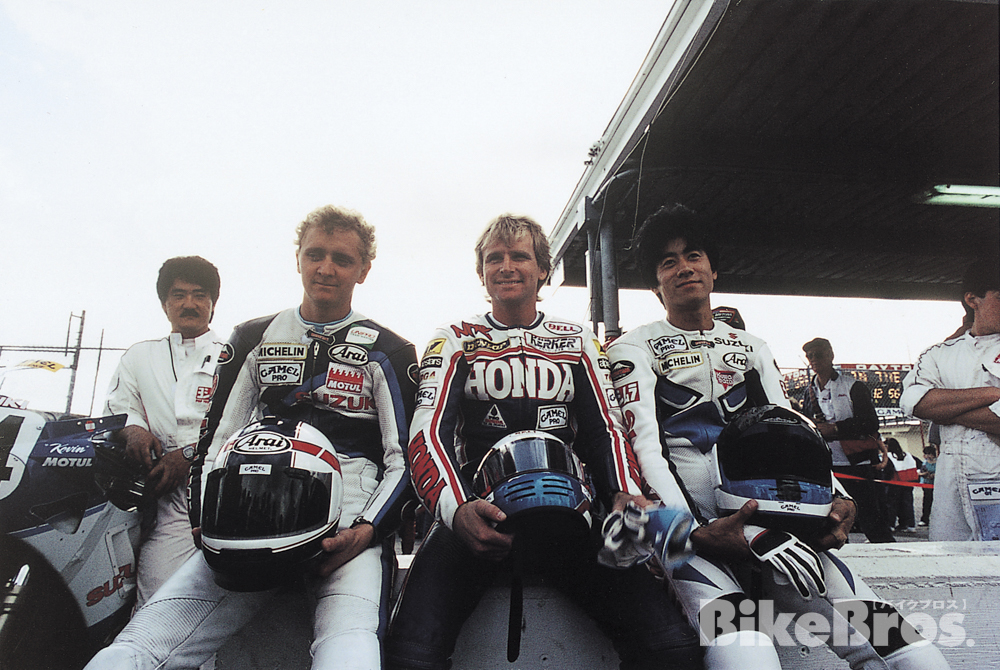
The Three Musketeers of the AMA Superbike racing. From left to right, Kevin Schwantz: born June 19, 1964 in Houston, Texas; Wayne Rainey: born October 23, 1960 in Downey, California; Satoshi Tsujimoto: born February 19, 1960 in Osaka, Japan. They were vigorous, absorbent, and above all, had unlimited potential. All three aspired to be GP500 World Champions.
Yoshimura History #24: Three rivals in the AMA Superbike Racing
1987 Three Dynamic Rivals
Satoshi Tsujimoto made a decision just before the 1987 season. He decided to compete in the AMA Superbike series full-time. His teammate (and rival) was Kevin Schwantz, and his bike was an oil-cooled GSX-R750 in its second season in the AMA. From Japan, Yoshimura mechanic Osamu Takenaka, who was in charge of Tsujimoto’s bike, accompanied the team. Takenaka was close in age to Tsujimoto (just one year younger), and they had become buddies. Another rival was American Honda’s Wayne Rainey and his VFR750F. 1987 AMA Superbike season was completely dominated by Tsujimoto, Schwantz and Rainey, and everyone expected the championship to be a showdown between the three of them.
However, in the season-opening Daytona 200 (March 8, Florida), the fastest and toughest man entered the race. It was American Honda’s wild-card rider Frederick “Fast Freddie” Spencer aboard a VFR750F. Unlike Wayne Rainey’s VFR750F, Spencer’s bike was a factory racer built from ground up by HRC aka Honda Racing. Looking at the exhaust system, for example, Rainey’s bike has a Kerker on the right, while Spencer’s has an HRC factory piece on the left. It was clear that Spencer’s bike was the special of the specials, with a much more powerful engine than Rainey’s.
Competing against Spencer’s VFR750F, the Yoshimura Suzuki GSX-R750 changed its tires from 18-inch Dunlop bias front and rear to 17-inch Michelin radial front and rear. This change from bias to radial not only signaled a new era for tires, but also meant that the latest technology from Grand Prix racing was now available for American superbikes. Michelin radials were the tires of choice for the Honda, Yamaha, Suzuki and Cagiva factory teams in the GP500. Both of the Yoshimura riders were on Michelin radials, and American Honda had Spencer on Michelin radials and Rainey on Dunlop radials.
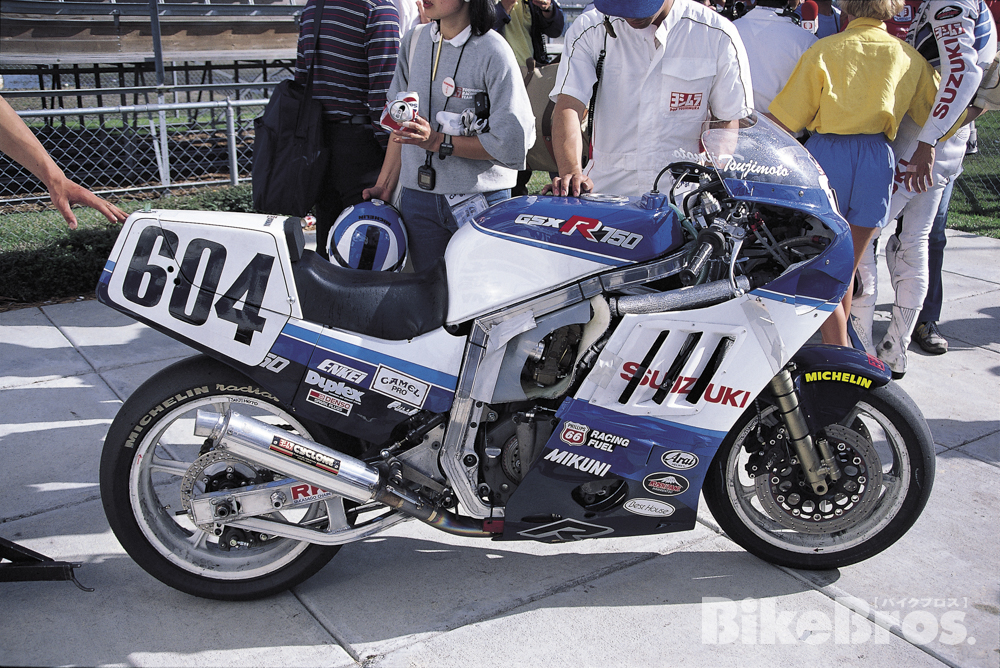
1987 Yoshimura Suzuki GSX-R750 wearing Michelin radials. Compared to bias tires, the radial tires provided better grip and generated less heat. In the heyday of bias tires, the internal pressure was set as high as 3kg/cm2 to ensure rigidity and prevent heat build-up, but with the switch to radial tires, this was no longer necessary. The forks on the bike are machined 43mm KYB’s with external reservoirs, and are based on those used on the GP500 factory machines. Note that the 1987 Duplex Cyclone race pipe had the exhaust chamber moved from the front of the exhaust pipe to the rear (engine side).
For this year’s Daytona 200, the top 10 qualifiers (the first two rows of the grid) were determined by Qualifying Timed Practice, 11th through 60th positions were determined by the results of the 50-mile Sprint Heat (a qualifying race in which the entrants are divided into two groups), 61st through 75th positions were determined by qualifying time, and 76th through 80th positions were determined by qualifying time and previous year’s series standings. With a final grid of 80 bikes, 59 bikes will run in Heat 1 and 58 bikes will run in Heat 2, and some riders will fail to qualify. Even if a rider fails to qualify, there is a 7-lap Consolation Race and the rider is always allowed to race. This is one of the great things about the American way of running a race.
Daytona Bike Week is a long one. On Monday there was the registration, on Tuesday the free practice and on Wednesday the timed practice. The top time was set by Spencer, whose 1:54.572 was the fastest time on the 3.56-mile road course —- Tri-oval with 31-degree east and west banking, along with the infield course, in use since 1985 —- followed by Schwantz, Rainey, and 4th place Tsujimoto (1:55.765), all of whom beat the 1:56.228 set by Eddie Lawson (aboard a Yamaha FZ750) in previous year’s timed practice.
After setting the fastest lap, Spencer was unable to avoid a fallen bike at the first infield hairpin (International Horseshoe) and crashed into it. Spencer and his VFR750F went airborne and then slammed into the track surface, resulting in him breaking his right collarbone. The three-time world champion, who won the GP500 in 1983 and the GP250 & GP500 in 1985, was absolutely unlucky as his 1986 season was cut short by injury and he was supposed to be in good shape and fully recovered for the 1987 season by the time of Daytona Bike Week.
Friday’s 50-mile race was shortened from 15 laps to 10. On the second lap of the first heat, Tsujimoto passed Schwantz to take the lead, and then went on to win by 5 seconds in 5 laps, and finally by 8.4 seconds in just 10 laps. This was Tsujimoto’s first win at Daytona.
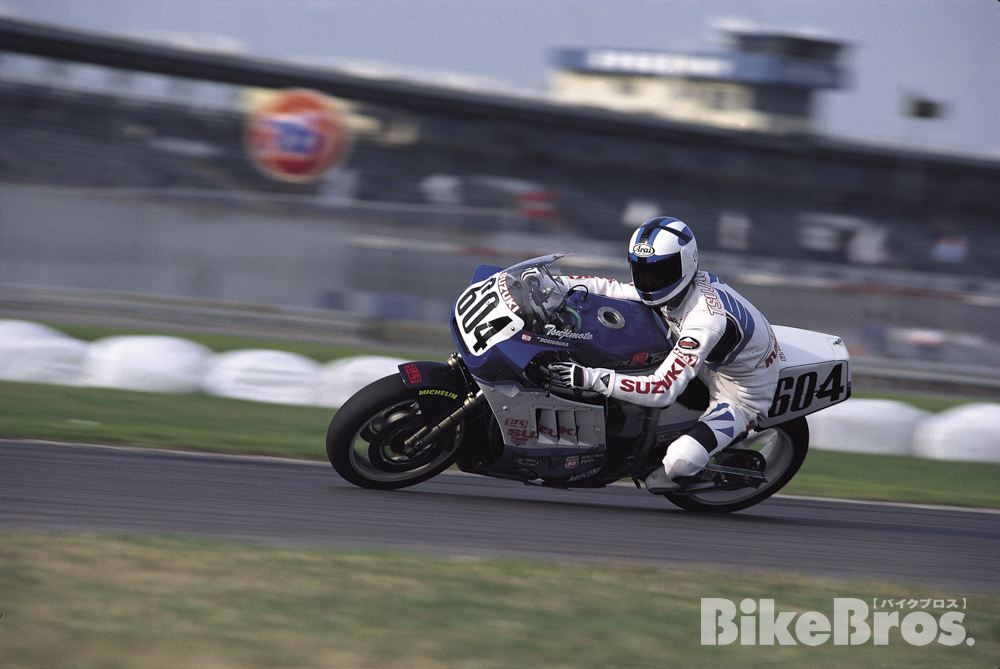
Tsujimoto entering the left turn from the Daytona infield just before the 31-degree west banking. His racing number #604 changed to #114 from the official qualifying for Round 2, Road Atlanta. U.S. Yoshimura changed the bike’s color scheme from red/black/white (1986) to blue/white (1987) in accordance with the production version.
Schwantz was moved up to start on pole position after Spencer was forced to pull out of the race due to a crash, but he had trouble with his engine occasionally losing revs, and he barely managed to finish in 2nd place. Based on Schwantz’s comments, the cause of the trouble appeared to be a faulty ignition system. Since the Daytona Speedway did not allow garage maintenance at night, Schwantz’s bike was taken to a motel where the Yoshimura team was staying, and the cause of the trouble was thoroughly investigated.
In Heat 2, Rainey went pole to win. Second place went to Jimmy Filice (American Yamaha) and third to Rueben McMurter (Canadian Yamaha). There seemed to be a lot of potential in the new FZR750.
Just prior to Sunday’s Daytona 200 race (200 miles, 57 laps, 1:30pm start), a 5-lap prize race Camel Challenge was held at 12:00p.m. with the top six finishers; Schwantz, Rainey, Tsujimoto, Marshall, McMurter and Ashmead. The Camel Challenge had been a familiar event on dirt tracks, and this was the first time it had been held in a road race. Rainey, who is also a dirt tracker, won the race and took home $10,000 in prize money, with Schwantz second at $5,000 and Tsujimoto third at $2,500.
In the 46th Daytona 200, Rainey and Schwantz jumped out at the start, followed by Bubba Shobert, who took the engine from Spencer’s bike, McMurter and Tsujimoto. On Lap 2, Schwantz takes the lead after a fierce battle with Rainey. On Lap 4 Schobert crashed and retired at the chicane, allowing Tsujimoto to move up to 3rd. The battle between Schwantz and Rainey continued and by the end of Lap 8, Schwantz had a slight lead of 1.3 seconds over Rainey. Schwantz maintained a good lap time in the 1:57 range and gradually increased his lead to 4.6 seconds by the end of Lap 18. On Lap 19, during the routine pit stop, Rainey pitted for fuel and tires while Schwantz pitted for fuel only. Schwantz took a risk, but the difference in strategy increased the gap between the two to 15 seconds. He then set the fastest lap of the race, but on Lap 34 he lost the front end while trying to pass a backmarker from the outside at the chicane and crashed, losing not just 13.2 seconds, but the whole race. This put Rainey in the lead and Tsujimoto in 2nd place without much effort. 3rd place went to privateer (Texas Corsair Racing) Doug Polen aboard a GSX-R750. Polen was the prize-money king of local racing, having won 61 box stock races (races for unmodified production bikes that are stock except for mufflers, rear shocks, and other parts that can be easily replaced), including the Suzuki National Cup series (commonly known as the GSX-R Cup race) that began in 1986.
The race went on and Rainey won the Daytona 200 for the first time. His race time of 1 hour 53 minutes 58.269 seconds was 51.387 seconds faster than the previous year’s winner Lawson. Tsujimoto, in 2nd place, was 17.209 seconds behind Rainey. Schwantz, who crashed at the top, was 13-14 seconds ahead of Rainey, so if Schwantz had won, Tsujimoto would have been about 30 seconds behind. Tsujimoto’s 2nd place in the Daytona 200 was the highest Japanese finish, surpassing Takazumi Katayama’s 3rd place in 1977, but he was not happy at all. The big winner was Polen in 3rd place.

#604 Tsujimoto being led by #34 Schwantz at Road Atlanta. From the second round of the Superbike season, with the exception of Laguna Seca and Willow Springs, all of the tracks were new to Tsujimoto. The race track at Road Atlanta was a different world from that of Daytona, a technical course with many ups and downs built on lush green hills, which Tsujimoto enjoyed. The course layout, of which nothing similar exists in Japan, is what makes it so fun to learn.
After the Daytona 200, Tsujimoto decided to concentrate on racing in the United States and moved to the town of Diamond Bar, near Los Angeles, where he began living in a two-bedroom resort-style condominium. The city of Chino, where Yoshimura R&D of America is located, was just around the corner.
Then came Round 2 at Road Atlanta (May 17, Georgia). Until the free practice session, Tsujimoto had been the #604 non-AMA licensed foreign rider, but from the qualifying session, he became the #114 AMA licensed rider. He is now officially an AMA rider.
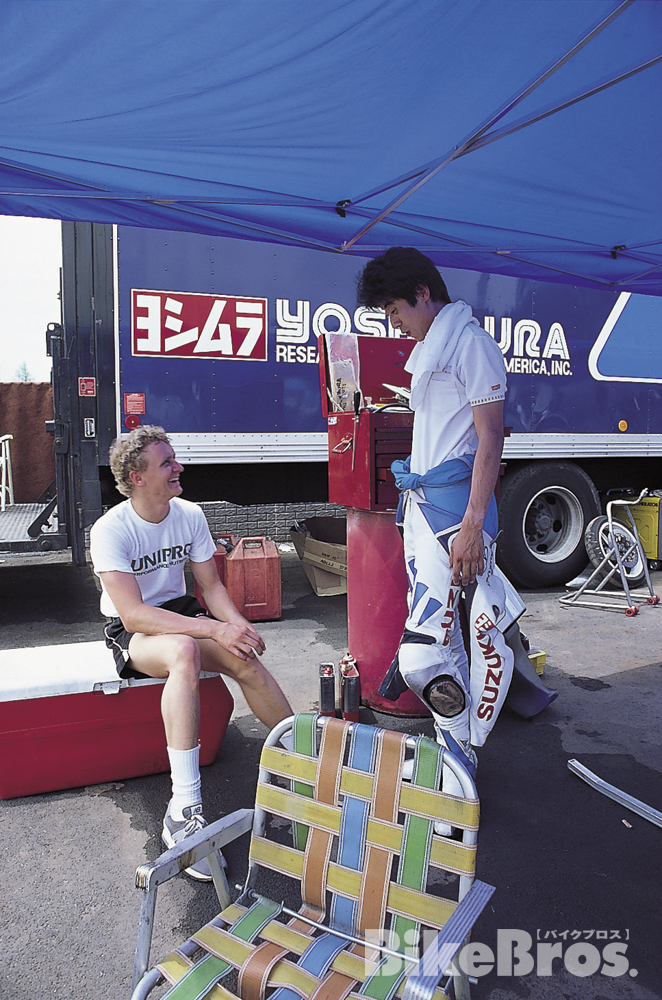
Schwantz (left) and Tsujimoto developed a relationship as good rivals but also as best friends. The cycle of Tsujimoto setting a lap time and Schwantz immediately rewriting it was repeated over and over again, and the battle against themselves with mutual awareness of each other continued throughout the free practice. The two are good buddies, with Tsujimoto frequently borrowing Schwantz’s car, but on the race track, it’s a different story.
However, a problem occurred after the heat races (consisting of two Heats) to determine the qualifying grid. Tsujimoto, who finished 3rd in Heat 1, and Polen, who finished 1st in Heat 2, were found to have violated the minimum weight requirement during the technical inspections following the heat races. The minimum weight for AMA Superbikes that year was 390 pounds (approx. 176.9 kg), with Tsujimoto’s bike weighing 386.5 pounds and Polen’s 385.5 pounds. The reason for this was that the mechanic in charge of the Tsujimoto’s bike had forgotten to load lead weights. The Yoshimura Suzuki GSX-R750 was built lighter than the minimum weight and required weights (usually mounted on the lower tubes or seat rail) to match the minimum weight. Schwantz and Randy Renfrow’s GSX-R750 were both 0.5 pounds lighter at 389.5 pounds. Conversely, the heaviest was Rainey’s VFR750F at 402 pounds.
However, the scales were found to be off by 0.5 pounds (8 ounces) depending on weather conditions, and the AMA certified that anything less than 8 ounces was an error. As a result, Schwantz and Renfrow, who were 0.5 pounds lighter, were overlooked, and only Tsujimoto and Polen were disqualified. The truth remains a mystery as to whether the management felt that they could not disqualify two of the three main competitors, or whether there really was an error. Incidentally, the same weight scale was not used at Daytona.
The final was a fierce match race between Schwantz, who started from pole position, and Rainey; with Rainey eventually winning by 1.52 seconds, and Schwantz losing a close race to finish 2nd.
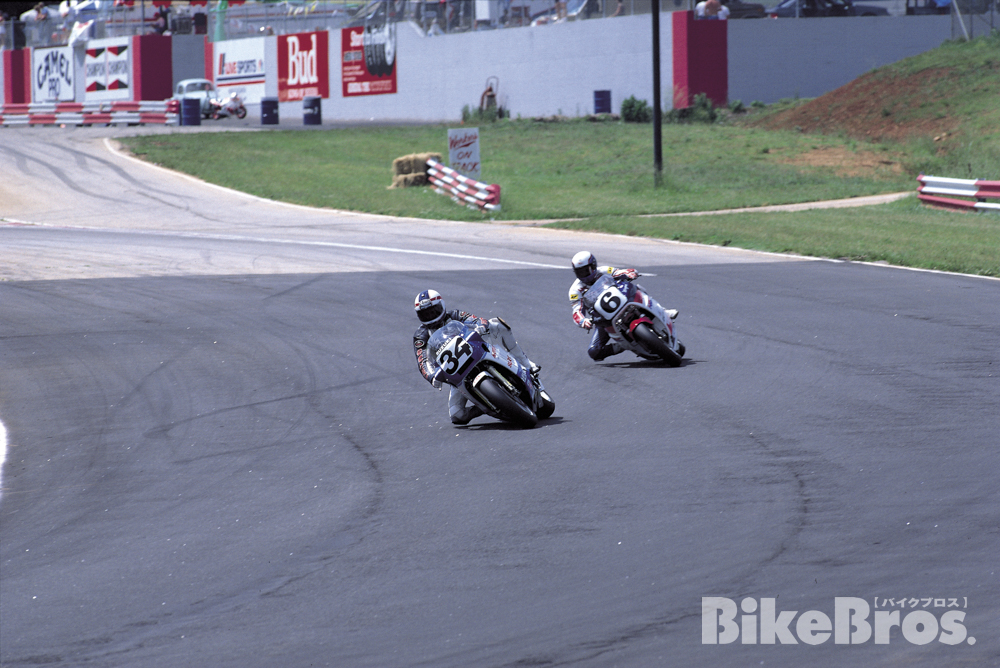
#34 Schwantz being chased by #6 Rainey. After Tsujimoto dropped out, the 1987 AMA Superbike season became a complete match race between the two. And so it continued in the GP500 from 1988.
The accident occurred during Saturday’s free practice session for Round 3 at Brainerd (June 7, Minnesota). In the high-speed Turn 1, where each bike entered at 160 mph (approx. 257.44 kph), Schwantz lost the front end and crashed, and Tsujimoto, who was riding right behind him, crashed heavily after riding up onto Schwantz’s bike. For his first time on the race track, Tsujimoto had his colleague Schwantz lead the way, but unfortunately the strategy backfired. Schwantz suffered only a swollen right ankle and abrasions from the track surface, whereas Tsujimoto broke his cervical vertebrae and left ankle. Tsujimoto was rushed to Brainerd Hospital and from there was airlifted to a larger Minneapolis hospital.
Round 3 main event was won by Rainey, who started from pole position, with a 4.9-second lead over Schwantz.
“It was a racing accident,” Tsujimoto said, but Schwantz was in tears at the hospital where Tsujimoto was. After that day, Schwantz changed. He felt responsible for his teammate’s accident, but this job comes with risks. Dwellers of the high-speed world bear freedom, courage, and responsibility.
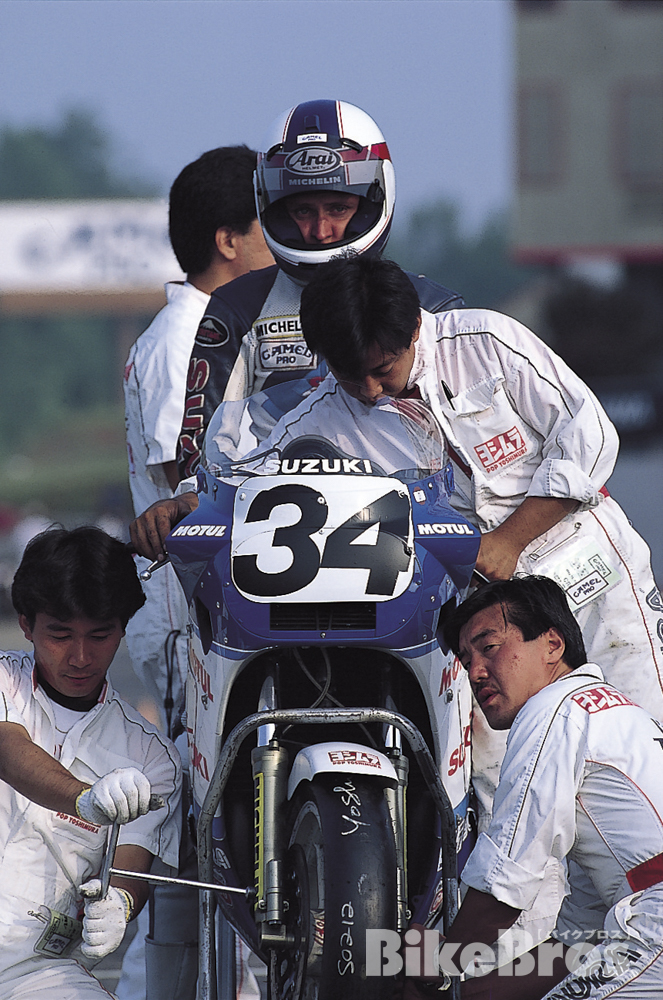
The team staff also noticed a change in Schwantz after the accident. His demands for the bike also changed from rather vague to more detailed and specific.
Schwantz won 5 of the remaining 6 races in the 1987 season. He also continued to make spot entries in GP (3 rounds with the new V4 RGV-Γ500) as in the previous year. His riding style changed from a lean-in style to a slightly leaned-out style, more like his later style, and he became more aggressive in controlling the bike. In addition to speed, he was beginning to develop a competitive edge.
What does it take to become Champion? Schwantz was unable to become the 1987 AMA Superbike Champion by 9 points, finishing 2nd in the standings. The title was taken by Rainey, who won three straight after the opening round (and then four 2nd places). The two lifelong rivals moved their battle to the world’s most prestigious GP500 in 1988.
============================================================
Published on August 25, 2023
Stories and photos supplied by Yoshimura Japan / Takao Isobe / Tatsuo Sakurai / Tomoya Ishibashi
Written by Tomoya Ishibashi
Edited by Bike Bros Magazines
